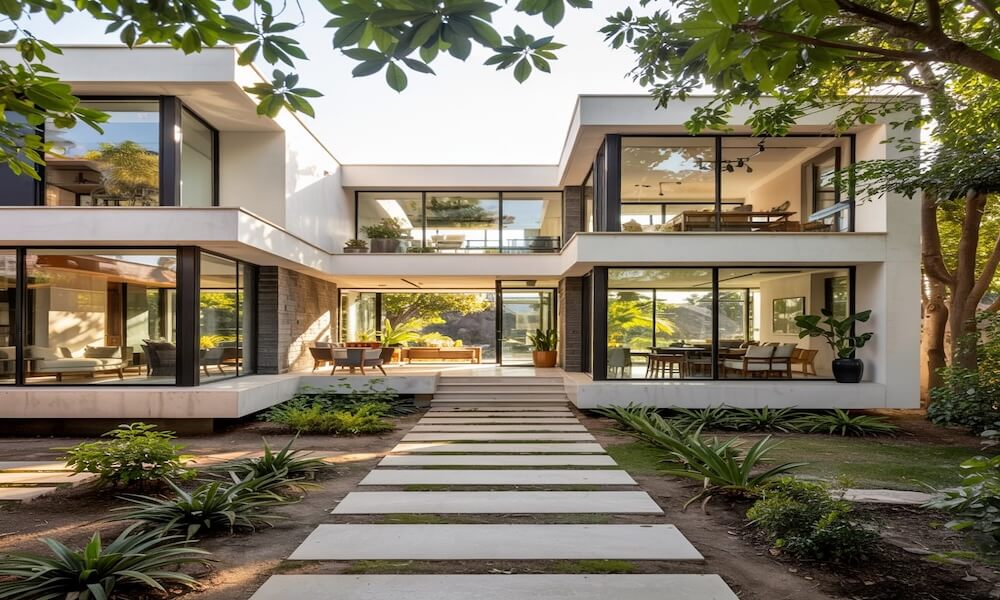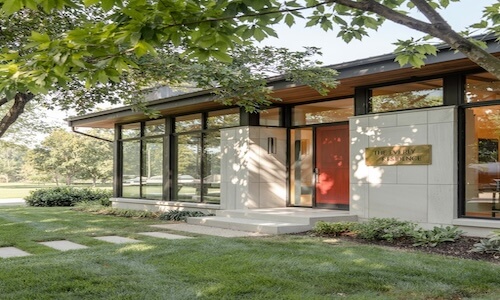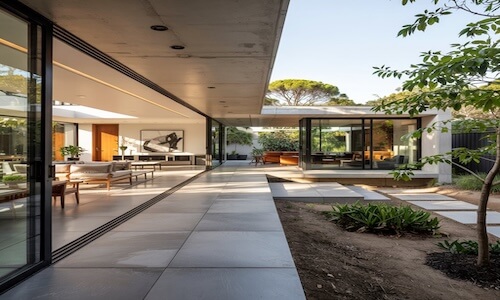Maximizing Natural Light
Maximizing Natural Light in Custom Homes: Bright Ideas for a Healthier, Happier Space
When building a custom home, one of the most powerful design elements you can focus on is natural light. Not only does sunlight make a space feel larger, warmer, and more inviting—it also boosts mood, reduces reliance on artificial lighting, and can even lower your energy bills. By intentionally planning for natural light in your custom home’s layout and features, you’ll create a space that feels vibrant and connected to the outdoors.
In this article, we’ll explore practical and creative strategies to help you maximize natural light in every part of your custom home.

1. Orientation: Start with the Sun’s Path
Designing a naturally bright custom home begins with understanding how the sun moves across your property.
Best Practices:
- South-facing orientation (in the Northern Hemisphere) provides consistent daylight throughout the year. This is ideal for main living areas like the kitchen, living room, and dining room.
- East-facing windows bring in morning sunlight—perfect for bedrooms or breakfast nooks.
- West-facing rooms get warm afternoon sun but can also overheat, so use wisely and consider shading.
- North-facing spaces provide soft, indirect light that works well for home offices, studios, wellness areas or utility areas.
By aligning your home with the sun’s path, you’ll naturally brighten interiors and make passive heating and cooling more effective.

2. Window Placement: Strategically Bright
Windows are the most obvious way to bring in natural light—but it’s not just about quantity. Strategic placement matters more than sheer size or number.
Tips for Window Layout:
- Balance large and small windows to ensure consistent lighting throughout the day.
- Place windows across from each other (called “daylighting”) to allow sunlight to bounce and fill a room evenly.
- Use tall windows to let in more vertical light, especially in living areas with high ceilings.
- Add corner windows or wrap-around glazing to open views and pull light from multiple angles.
Don’t forget to consider privacy and heat gain in window planning. In bathrooms or bedrooms, use frosted or textured glass to maintain light without sacrificing discretion.
3. Skylights and Solar Tubes: Let Light in from Above
When traditional windows aren’t an option—like in interior bathrooms, closets, or hallways—skylights and solar tubes are excellent alternatives.
Skylights:
- Great for brightening up central rooms with no exterior walls.
- Fixed or operable styles available—some even open to let in fresh air.
- Look for energy-efficient glazing to reduce heat gain and glare.
Solar Tubes (or Sun Tunnels):
- Ideal for tight spaces where a skylight isn’t feasible.
- Use a reflective tube to channel sunlight from the roof into any room.
- Easier and less expensive to install than full skylights.
These overhead light sources can dramatically transform dark or windowless areas.
4. Glass Doors and Transoms: Beyond the Window
Expand your natural lighting strategy with glass doors and interior transoms—subtle design choices that let light flow more freely throughout your home.
Glass Doors:
- Sliding or folding patio doors (like bi-fold or pocket styles) open wide to outdoor light and views.
- Front entry doors with glass panels bring daylight into the foyer.
- Interior glass doors between rooms share light while maintaining separation.
Transoms:
- Small, horizontal windows above doors or walls allow daylight to pass from room to room.
- Useful in shared spaces like hallways or between a bedroom and bathroom.
These design elements act like “light bridges,” pulling sunlight deeper into your interior.

5. Interior Design Tricks to Amplify Natural Light
Your finishes, materials, and layout choices all affect how light moves and feels in your home.
Color Palette:
- Light-colored walls and ceilings reflect sunlight rather than absorb it.
- White, soft gray, pale blue, or beige can help maximize brightness.
- Consider glossy or satin finishes over matte to bounce light around more effectively.
Reflective Surfaces:
- Use mirrors, glass, polished stone, and even metallic accents to scatter light across a space.
- A large mirror across from a window doubles the perceived daylight.
Open Layouts:
- Keep rooms visually connected for better light flow.
- Avoid heavy partitions or oversized furniture that blocks light paths.
By choosing reflective and airy design elements, you make the most of the light that’s already coming in.
6. Landscaping and Exterior Considerations
What happens outside your home also influences how much light makes it inside.
Things to Keep in Mind:
- Trim trees or shrubs that block sunlight near key windows.
- Use deciduous trees on the south or west side to offer summer shade and winter light.
- Light-colored exterior walls or patios can reflect sun into adjacent rooms.
Outdoor features like pergolas, awnings, and louvers also help control light and heat without shutting it out completely.
7. Smart Glass and Window Treatments
If you’re concerned about glare, heat, or privacy, there are plenty of modern solutions that don’t sacrifice sunlight.
Consider:
- Low-E glass windows to block UV rays and control temperature.
- Motorized blinds or shades that you can schedule or control with an app.
- Smart glass that tints automatically based on light levels.
These tools offer the best of both worlds—plenty of daylight with energy efficiency and comfort.

